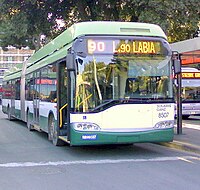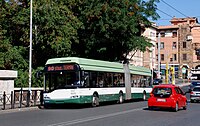Trolleybuses in Rome
| Rome trolleybus system | |||||||||||||||||||||
|---|---|---|---|---|---|---|---|---|---|---|---|---|---|---|---|---|---|---|---|---|---|
 | |||||||||||||||||||||
| Operation | |||||||||||||||||||||
| Locale | Rome, Lazio, Italy | ||||||||||||||||||||
| Infrastructure | |||||||||||||||||||||
| Electrification | (?) V DC parallel overhead lines | ||||||||||||||||||||
| |||||||||||||||||||||
| |||||||||||||||||||||
The Rome trolleybus system (Italian: Rete filoviaria di Roma) forms part of the public transport network of the city and comune of Rome, Italy. In operation since 2005, the current system comprises three routes (60, 74 and 90).
From 1937 to 1972, Rome was served by a much more extensive trolleybus system, which was then the largest in Italy and one of the largest in Europe.
History[]
The first trolleybus system (1937-1972)[]
The first route of Rome's original trolleybus system was inaugurated on 8 January 1937. In later years, that system was greatly expanded at the expense of conventional buses, which were regarded at the time as slow and uncomfortable[1]
Following the suspension of trolleybus services due to World War II, the system was restored and expanded during the post-war era, reaching its maximum length of 137 km in 1957.
In the 1960s, the trolleybus system (as well as Rome's tram network) was considered outdated and costly to maintain. The trolleybus routes were therefore rapidly replaced by conventional buses.
On 2 July 1972, operations ceased on the last surviving trolleybus route of the original system, no. 47 (Porto di Ripetta - Santa Maria della Pietà).
The current system (since 2005)[]
In the early 2000s, Rome's municipal administration decided to reduce car traffic and air pollution by strengthening urban public transport in central Rome, and particularly those forms of public transport powered by electric traction. The administration decided to improve the tram network (but in fact it was reduced), and by reintroducing trolleybuses on the most popular bus routes.
On 23 March 2005, trolleybuses took over the operation of route 90 Express, and on 1 December 2008, the route 90D Express was established. On 18 June 2012, the Express Line 90D was suspended. On 8 July 2019 the new trolleybus route 74 was inaugurated. It runs on a dedicated corridor from Metro Laurentina to Fonte Laurentina.
Service[]


- 90 Express Termini station ↔ Largo F. Labia (11.5 km (7 mi));
The section of the route from Termini station to Porta Pia is not electrified by overhead wires, as it was considered that the two-wire overhead lines would have disfigured the city centre streets. On that part of the route, the trolleybuses are powered by onboard batteries, which are automatically recharged along the sections where wires are provided.[2]
- 60 Express Largo Pugliese ↔ Piazza Venezia (electrified only between Porta Pia and Piazza Sempione);
- 74 Metro Laurentina ↔ Fonte Laurentina (5.5 km (3 mi));
Trolleybus fleet[]
The trolleybuses used for the operation of the present system are Solaris Trollino 18 articulated vehicles, with electrical equipment supplied by Škoda Transportation subsidiary Ganz Transelektro. The Trollinos are 18 m (59 ft 1 in) long, 2,550 mm (8 ft 4 in) wide and 3,490 mm (11 ft 5 in) high. They are fitted with a battery system to enable operation over the non-electrified section from Termini station to Porta Pia.
In addition, 45 BredaMenarinibus Avancity HTB were acquired in 2010. The Avancity are equipped with a diesel generator and electrical equipment by Škoda Transportation.
See also[]
- Trams in Rome
- Rome Metro
- List of trolleybus systems in Italy
References[]
Notes[]
- ^ The tram lines had been removed from the city centre in 1930, on the orders of Mussolini.
- ^
"Filovie di Roma" [Trolleybuses of Rome] (PDF). iBinari+CityRailways website (in Italian). www.cityrailways.it. Retrieved 5 March 2011. External link in
|publisher=(help)
Further reading[]
- Gregoris, Paolo; Rizzoli, Francesco; Serra, Claudio (2003). Giro d'Italia in filobus [Tour of Italy by trolleybus] (in Italian). Cortona: Calosci Editore. ISBN 88-7785-193-7.
External links[]
![]() Media related to Trolleybuses in Rome at Wikimedia Commons
Media related to Trolleybuses in Rome at Wikimedia Commons
This article is based upon a translation of the Italian language version as at March 2011.
- Trolleybus systems by city
- Trolleybus transport in Italy
- Transport in Rome



